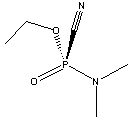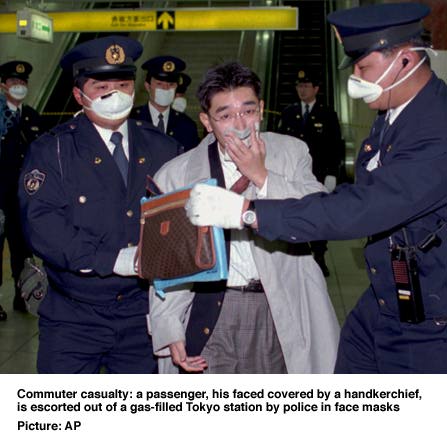


Toward the end of 1936, Dr Gerhard Schrader, a German scientist researching organic phosphorus compounds, spilt a small drop of a chemical he named Tabun on his bench. He and three of his assistants in the room were blinded by their pupils contracting to pin heads, and they experienced severe difficulty in breathing. It took them three weeks to recover from the single drop of tabun. By January 1937, Schrader had been summoned by the Nazis to demonstrate the power of the new chemical to the Wehrmacht. Tabun is odourless, colourless, and poisonous by inhalation or by penetration through the skin - perfect for a military nerve gas. Although it was not known how Tabun worked until the late 1940s, the Army ordered Schrader to continue his work in the Ruhr, with brand new laboratories installed for the purpose. One year later, after mass production of Tabun had begun, he discovered a compound he described as having an "astonishingly high toxicity", isoproyl methylphosphonofluoridate. He named it Sarin, after the four key contributors, Schrader, Ambros, Rüdriger, and van der Linde. After the invasion of Poland, Hitler told a huge audience at Danzig of "fearsome new German weapons, against which his enemies would be defenceless". That same month, a new factory was ordered to be built, capable of producing a thousand tons of nerve gas a month. Criminals and prisoners who had been "sentenced to death" were used to test the chemicals, but almost certainly on inmates of the concentration camps too.
Tabun was being manufactured in gigantic proportions, and by 1944, 12 000 tons had been stock piled in shells and bombs, and Sarin had been developed three factories to be built, each producing 500 tons a month. Hitler called the nerve gases his "Siegwaffe"; his victory weapon, but even in 1944 , when his armies were suffering terrible defeats, Hitler refused to order their use. It is possible even he was not able to bring himself to use them, especially after he experienced the effects of gas attacks at Flanders in the First World War. Three of the most fanatical Nazi leaders, Bormann, Goebbels and Ley, repeatedly urged Hitler to unleash the nerve gas. Goebbels wanted to use it as revenge for the distruction of Dresden. Albert Speer, the Minister for Armaments in the Third Reich claimed at the Nuremberg trials that he had prepared to assassinate Hitler by injecting Sarin into the ventilation system of the Führerbunker.
By 1945 it was too late for Hitler to use the thousands of tons of Tabun and Sarin he had stockpiled, he had lost most of his bombers and he would have sparked a huge retaliation from the Allies. His ministers had secretly diverted supplies from the chemical factories and hidden ammunition to prevent him from doing anything rash. As early as August 1944, Nazi chemists had begun destroying the documents which described the research and manufacture of sarin. On 23 January 1945, the factory at Dyhrenfurth was closed down, and almost all evidence of the nerve gas destroyed. Tons of the liquid nerve agent was poured straight into the River Oder. So desperate were the Germans to stop the Russians getting their hands on Sarin, the Luftwaffe were ordered to bomb all nerve gas factory units still intact. Most of the attacks failed, importantly the new Falkenhagen plant was left untouched, now capable of producing 500 tons of sarin a month. The factory had also been involved in research into related chemicals, including soman, or GD, known to be 150% more lethal than sarin. The German High Command had ordered the research to be buried in a mine shaft ten miles east of Berlin, but under torture a chemist at the plant gave the Russians the whereabouts of the papers. Within 4 months, the whole plant had been reassembled on the banks of the Volga, and was back in production.

|

|

|
|
|
|
|
Although most of the scientists involved in the research of sarin finished the war in British or American zones, the short term threat of Russian nerve gas attack was frightening. Western discomfort was made more acute when it was announced in June 1947 that a Stalin Prize, First Class, had been awarded to Alexander Arbusov for "investigations in the sphere of phosphorous - organic combinations". This ensured the survival of post-war chemical defence plants. By the early 1950s, sarin took a side line as the two superpowers poured resources into the research of biological weapons. In 1956, the British Ministry Of Defence pulled out of all research for economic reasons, but two years later Porton Down, then the largest chemical weapons plant in the West - based on Salisbury Plain, UK, initiated discussions with their American and Canadian counterparts. The Thirteenth Tripartite Conference on Toxicological Warfare was held in Canada in 1958. Although all three countries were politically committed to purely defensive research, they pooled their information, and decided that the best defence was to continue searching for better and newer chemical weapons in order that they could defend against them. They finally concluded that "all three countries should concentrate on the search for incapacitating and new lethal agents....[and] research should be continued on sarin and other organophosphorous compounds, specifically in areas where there is a possibility of marked enhancements in speed of action and resistance to treatment".
|
|
|
|
|
|
|
|
The Iraqis were thought to have had large stock piles of a nerve gas, and there is growing evidence that sarin is still being stockpiled by Saddam Hussein, along with anthrax. The suspicion caused the allied armies to provide antidotes to all personnel. An illness, dubed "Gulf War Syndrome", is suffered by many veterens of the conflict. The syptoms are very similar to very mild sarin poisoning, but many belive it is caused by anti-nerve gas pills given to army personnel (see the medicine section). The current policy of the CIA is that any symptons are due to sarin gas released during US bombing of chemical factories. It is clear Iraq is building up its chemical weapons stockpile, with outside help. Most current intelligence reports are still classified, but from those which are not (ref. here), it is clear the CIA is worried about another Irawi uprising, including a sarin attack using missiles being manufactured. The Allied attacks probably destroyed the Iraqi capacility to deploy sarin and anthrax rather than their actual stockpiles. It is also thought, however, that most stockpiles are very impure and therefore have a short shelf life. During the war it wasa under a fortnight, now thought to be up to three months. It is thought that the Iraqis now have enough fresh sarin and anthrax built up to be fatal to the whole world population (Daily Telegraph 12 October 1995).

On 20th March 1995, 12 commuters were killed and 5500 injured, by a sarin gas attack on the Tokyo underground system. The gas used was only 20% pure, but yet has left over a hundred people with lasting nervous system damage. It is suspected the gas was released from a small test tube near a ventilation intake duct.
The attack was perpetrated by a religious cult named the Aum Supreme Truth, and led by Shok Asashara. They had tested sarin in a remote cattle station in Western Australia from September 1993, and then continued their manufacturing process back in Japan. Japanese officials found traces of the gas all over the Aum's Tokyo estate near Mount Fuji, but have only recently convicted actual individuals. The Aum claimed the sarin was sprayed on by the US military paid by the Freemasons. The group also carried out a second attack which killed 5 and injured 50, including two judges who were about to rule on a land dispute involving one of their farms.
The Electronic Daily Telegraph (16 May 1996) reported that the London Underground had put into place contingency plans for a similar attack in the capitol. The Aum had built a plant which was capable of producing 70 tons of sarin with relative ease, with simple components. They had also sent an exhibition party to Zaire to find samples of the Ebola virus.
The ease at which nerve gas can be made if a chemist is willing to make a few risky shortcuts makes it a worrying threat to terrorist targets especially in the West. The US Office of Technology Assessment noted that a light plane carrying 100kg of anthrax spores and equipped with a crop sprayer, could deliver a fatal dose to three million people.